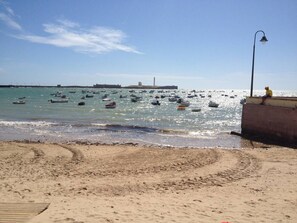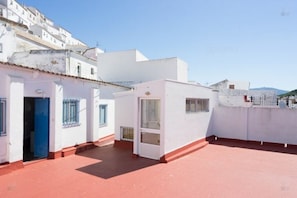Accommodation:
Houses skylight, sunny day at the Real street of Alcala de los Gazules, accommodation boasts wonderful views oriented park the Acorns terrace. The two-story house has five bedrooms, a double bed. 3 bunk beds and 6 single beds and a high bed, has all the household linen necessary for a pleasant stay (sheets, towels, comforters, etc ...)
It offers free Internet access and cold pump / central heat.
Three bathrooms, one en suite, another very spacious in the central area of the house and a third upstairs. fully equipped kitchen, appliances and household items. Lounge, covered central courtyard, dining room and a large terrace-solarium on the top floor.
Environment:
Live healthy and enriching contact with nature experience. The house located in the heart of the Natural Park of the Acorns, Alcalá de los Gazules 60km from the capital (Cádiz) and Jerez de la Frontera and the beautiful beaches of the Costa de la Luz (La Barrosa, Los Canos de Meca, El Palmar, Tarifa, Bologna, etc ...)
The house in the historic town was declared a Historical Site in 1985, beautiful city of characteristic layout Andalusian, with its whitewashed houses and streets in slope flowing into bright spaces that contrast with the green of the oaks and form a beautiful reality that already in 1924, referred Federico Garcia Lorca when he wrote: "I who am Andalusian and requeteandaluz, sigh Malaga, for Córdoba, for Sanlúcar la Mayor, at Algeciras, for authentic and toned Cádiz, for Alcalá de the Gazules, so it is intimately Andalusian .... "
Activities and attractions:
You can combine a quality rest with recreational activities, hiking, bike, mountain, yoga workshops and meditation, hot baths (temascales) and sound baths (Tibetan bowls and gongs), and personal growth.
-The Picacho. recreational area located 9 km from the city. Here we find a "Classroom
of the nature".
Natural-park of the Acorns. protected area occupies 170 000 hectares in which you can find mongooses, otters, bobcats, deer, vultures, eagles and owls among others. The park enjoys atypical weather conditions to be a Mediterranean climate, influenced by the appearance of so-called "reefer" (river valleys of emerging water all year and sandstone terrain on which it sits). The result of this is that there are areas with very favorable for cork oak forests and vegetation typical of tropical microclimate Tertiary period (ferns, lichens, ...)
and of course the payoyas goats milk with exquisite cheeses The Gazul are made.
-Sports. The environment surrounding the town is ideal for numerous sports such as mountain biking, hiking, equestrian activities, swimming and water activities on the lake, free hang gliding and paragliding, we can make hiking to the Sierra del Aljibe, to climb the highest peak from which beautiful panoramic contemplated and all that can be practiced on the beaches of our province: surfing, windsurfing, sailing, diving, etc ...
-Beaches. Because it is located in the geographical center of the province and have very good communication networks in a few kilometers we approach the different and wonderful beaches of our Cádiz as are the beaches of La Barrosa-Chiclana, El Palmar Vejer de la Frontera, Los Canos de Meca, Bologna, Zahara, Tarifa, Rota, Sanlúcar, Chipiona, etc.
-Archeological sites. In the Laja of Irons rock carvings are schematic character and the Mesa del Esparragal is a site of origin Phoenician and Roman in him a Visigoth tower rises.
-Church Parish of St. George. It seems that was built in the fourteenth century (on the site of a former mosque) but has extensions and later reforms. We can consider it as to its Gothic arched cover, plant, etc. But they predominate baroque ornaments such as altarpieces. It has important artistic works like a painting of San Sebastian (Cavallini and Cimabue), the Virgen del Rosario (Martinez Montanes), the Recumbent Christ (Juan de Mesa), etc. In addition to other artistic treasures such as choir books and works of jewelry.
-Church Of San Francisco. It is popularly known as the Victoria. It has a Latin cross and highlights the image of Jesus Nazareno (Jose Montes de Oca).
-Hermitage And sanctuary of the Virgen de los Santos. (Patron saint of the town) was erected to commemorate the victory in the "Battle of Salado". The name of the sanctuary is the "Jardal" and it is the largest collection of votive offerings of Andalusia is preserved. His pilgrimage is one of the most popular (September 12).
-Ruins Del Castillo and Arab walls. Castle is a tower only because the building was destroyed during the War of Independence. Also it left standing the Puerta de la Villa, although it is very reformed.
Ruta del Toro. so called because we can see the various herds of fighting bulls grazing free in their natural environment. Part from Arcos de la Frontera and ends at the Campo de Gibraltar. And Purebred Andalusian horses.





